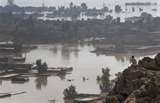 The Time of Cholera
The Time of CholeraWhat happens when over 10% of the population of a nuclear power is homeless, a $2 billion cotton crop is destroyed, 1.7 million acres of cropland are inundated, and cholera breaks out?
Floods have affected about one-third of Pakistan. Some of the worst flooding is in the Swat Valley, a focus of the worst Taliban fighting in recent years. The same area was hit hard by an earthquake in 2005, which affected over 3 million Pakistanis. Twenty million are affected now.
 There have been 36,000 suspected cases of potentially fatal acute watery diarrhea reported so far, many of which may be cholera. The disease is caused by the bacterium Vibrio cholerae, which rapidly dehydrates the host and can kill within hours of the onset of symptoms. It creates a salt-water environment in the small intestine, whose osmotic pressure can pull as much as six liters of water per day through the intestinal walls. Although treatment with antibiotics such as tetracycline can shorten the course of the disease, the primary treatment is to give a dilute mixture of saltwater and sugar orally or, in the most severe cases, intravenously. Prompt and aggressive treatment lowers the death rate to 1%, which otherwise can rise to 50% or 60%.
There have been 36,000 suspected cases of potentially fatal acute watery diarrhea reported so far, many of which may be cholera. The disease is caused by the bacterium Vibrio cholerae, which rapidly dehydrates the host and can kill within hours of the onset of symptoms. It creates a salt-water environment in the small intestine, whose osmotic pressure can pull as much as six liters of water per day through the intestinal walls. Although treatment with antibiotics such as tetracycline can shorten the course of the disease, the primary treatment is to give a dilute mixture of saltwater and sugar orally or, in the most severe cases, intravenously. Prompt and aggressive treatment lowers the death rate to 1%, which otherwise can rise to 50% or 60%.
Cholera is fairly easily controlled in developed countries that enforce water treatment and sewage disposal standards, but it's the devil to beat in a poor and flooded country, since it spreads through fecal contamination of water. All water used for drinking, washing, or cooking should be sterilized by boiling, chorination, ozone treatment, UV sterlization, or fine filtration, and how likely is that? Fine cloth filters lessen but do not eliminate the spread. Vaccines are under development but currently are administered only to health personnel and other very limited populations; methods of mass vaccination are still being studied.

Cholera pandemics claimed millions of lives worldwide in the 19th and early 20th centuries. An outbreak in London in 1853-54 led pioneering epidemiologist John Snow to remove the handle of the Broad Street pump, thus proving (by the immediate cessation of disease in the area) that cholera was spread by contaminated water via a means not fully understood (or widely believed) until many years later.
People with Type O blood are most susceptible to cholera, followed by Types B, A, and AB, the most resistant. The use of antacids, a weakened immune system, and malnourishment also heighten susceptibility. Some believe that non-symptomatic carriers of the cystic fibrosis genetic mutation are relatively resistant to cholera, just as carriers of the sickle-cell mutation are relatively resistant to malaria, which may explain why the genes for these awful diseases have not disappeared through selective pressure.

No comments:
Post a Comment